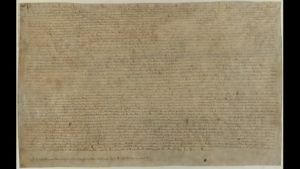Digital History
Document Preservation and Retrieval Activities
By Mark Ciotola
First published on February 15, 2020. Last updated on June 11, 2024.
Activity Objective
- Students will gain experience locating and retrieving historical documents.
Document Retrieval and Comprehension
The English constitution is thus far unwritten. However, an early document of rights was the Magna Carta. While English King Richard the Lionhearted was gallivanting around continental Europe and crusading in the Middle East, his brother Prince (then King) John (of Robinhood fame) was oppressing the peasants, and even worse for him, the nobility. The nobility rebelled and forced Prince John to sign the Magna Carta, which is the closest thing there is to a written English constitution, except it’s not.

An absurd American rendering of Prince John (credit: Disney, 1973)
Nevertheless, the Magna Carta is a fine example for this activity, because it’s the closest thing to an easy medieval document, except it’s not. However, it shares several common traits of old digitalized documents.
This being an English document, let’s start this adventure at the Britsh Library. If you are clever, you can grab a copy of a photograph of the Magna Carta from that site. I have done so here:

A photograph of the Magna Carta (2015)
What can you determine from this photo? What can’t you determine? Here is a link to another original at UK’s National Archives site. Does that help much? Can you recognize the characters? Can you identify and understand the words?
Fortunately, that site had another photograph of a different version of the Magna Carta. Different version? Yes, although the original Magna Carta was issued in 1215, a 1216, 1217 and 1225 versions were issued. Fortunately, the 1225 version is more readable. Look at it for yourself (use the magnifier): 1225 Magna Carta. Can you recognize the characters?
Here are additional links and tools by the Society of Antiquaries of London. You can see a text versus image comparison. Can you identify and understand the words now? Perhaps only if you know Latin. Such is the case with many ancient documents. Scanning and digitizing them is often not enough by itself.
Further, in pure scans, you cannot simply copy and paste the characters into Google Translate, because the characters have not yet been recognized or transcribed into computer characters. You could manually transcribe the document, or create an artificial intelligence application to recognize characters in an old scribe style.
Many famous documents have been translated. You have to trust the translator and know the context of the document, but it mat suffice to get you started with the document. The Magna Carta is famous and has been translated. Or see a US government archives translation. You should note and critically evaluate the source of the translation.
Try going through this process with another famous document from pre-industrial times.
« Document Preservation and Retrieval—Saving Old Information With New Technology | COURSE | Digging Deeper into Document Repositories »